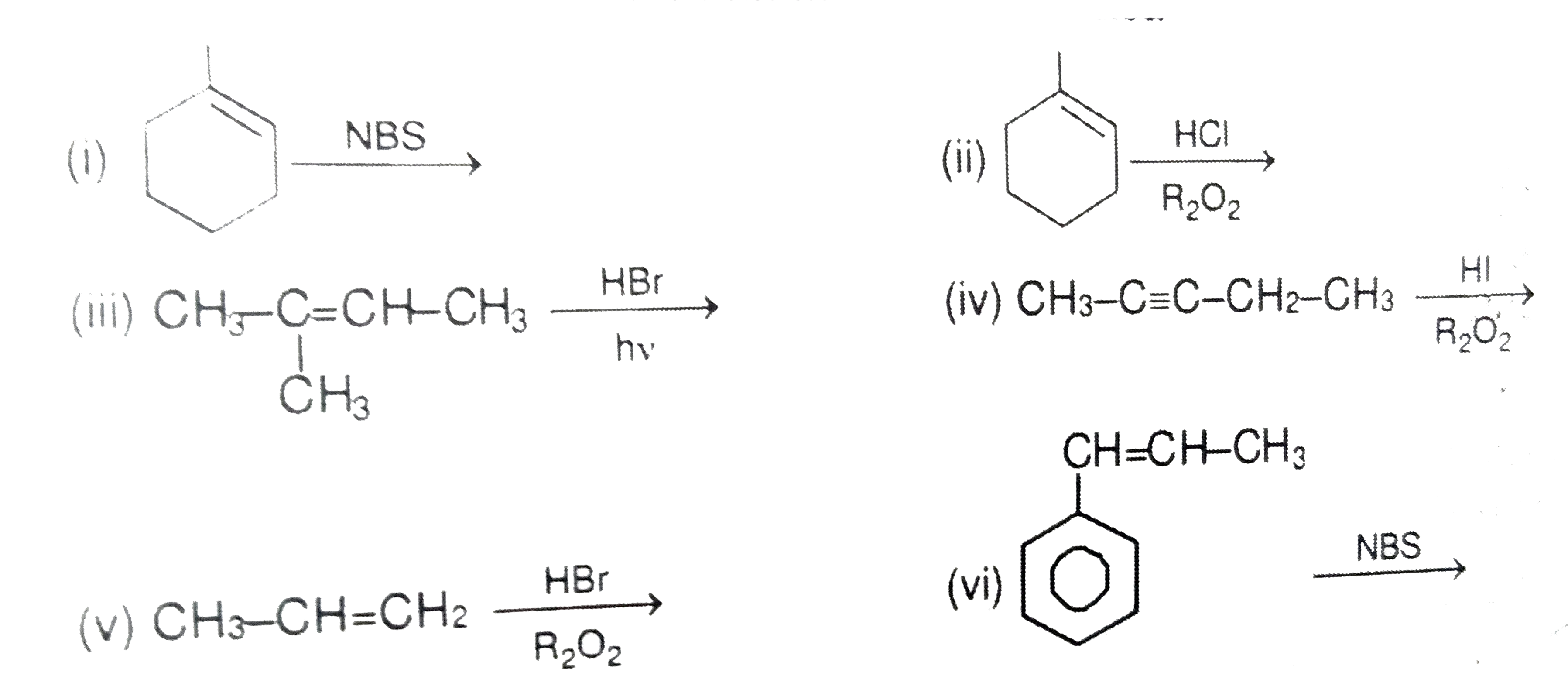Explain the addition of HBr to propene by electrophilic addition mechanism and free radical addition mechanism.
Step-by-Step Solution
1. Structure of Propene:
- Propene is an alkene with the molecular formula C3H6. Its structure can be represented as:
CH3−CH=CH2
- This shows that propene has a double bond between the second and third carbon atoms.
2. Electrophilic Addition Mechanism:
- The addition of HBr to propene follows the electrophilic addition mechanism.
- According to Markovnikov's rule, when HBr adds to an unsymmetrical alkene, the hydrogen atom will attach to the carbon with the greater number of hydrogen atoms (the less substituted carbon), while the bromine will attach to the more substituted carbon.
- In propene, the hydrogen will add to the terminal carbon (CH2), and bromine will add to the second carbon (CH).
- The reaction can be depicted as follows:
CH3−CH=CH2+HBr→CH3−CH(Br)−CH2
- The product formed is 2-bromopropane.
3. Free Radical Addition Mechanism:
- The free radical addition mechanism occurs in the presence of peroxides, which initiate the reaction.
- The overall reaction can be represented as:
CH3−CH=CH2+HBrperoxide−−−−−→CH3−CH2−CH2Br
- This mechanism involves three main steps:
Step 1: Initiation
- Peroxides undergo homolysis to form free radicals:
RO-OR→2RO⋅
- The alkoxy radical (RO·) reacts with HBr to produce a bromine radical (Br·):
RO⋅+HBr→ROH+Br⋅
Step 2: Propagation
- The bromine radical reacts with propene:
Br⋅+CH3−CH=CH2→CH3−CH(Br)−CH2 (secondary radical)
- Alternatively, it can also lead to:
Br⋅+CH3−CH=CH2→CH3−CH2−CH2Br (primary radical)
- The secondary radical is more stable than the primary radical, leading to the formation of 1-bromopropane as the major product.
Step 3: Termination
- The free radicals combine to form stable products, such as:
Br⋅+Br⋅→Br2
- Other free radicals can also combine to form various products, including:
CH3⋅+CH3⋅→C2H6 (ethane)
- The final products can vary depending on the reaction conditions.
Summary of Products:
- From the electrophilic addition mechanism, the product is 2-bromopropane.
- From the free radical addition mechanism, the major product is 1-bromopropane, along with other possible products.
---
- Propene is an alkene with the molecular formula C3H6. Its structure can be represented as:
CH3−CH=CH2
- This shows that propene has a double bond between the second and third carbon atoms.
- The addition of HBr to propene follows the electrophilic addition mechanism.
- According to Markovnikov's rule, when HBr adds to an unsymmetrical alkene, the hydrogen atom will attach to the carbon with the greater number of hydrogen atoms (the less substituted carbon), while the bromine will attach to the more substituted carbon.
- In propene, the hydrogen will add to the terminal carbon (CH2), and bromine will add to the second carbon (CH).
- The reaction can be depicted as follows:
CH3−CH=CH2+HBr→CH3−CH(Br)−CH2
- The product formed is 2-bromopropane.
- The free radical addition mechanism occurs in the presence of peroxides, which initiate the reaction.
- The overall reaction can be represented as:
CH3−CH=CH2+HBrperoxide−−−−−→CH3−CH2−CH2Br
- This mechanism involves three main steps:
- Peroxides undergo homolysis to form free radicals:
RO-OR→2RO⋅
- The alkoxy radical (RO·) reacts with HBr to produce a bromine radical (Br·):
RO⋅+HBr→ROH+Br⋅
- The bromine radical reacts with propene:
Br⋅+CH3−CH=CH2→CH3−CH(Br)−CH2 (secondary radical)
- Alternatively, it can also lead to:
Br⋅+CH3−CH=CH2→CH3−CH2−CH2Br (primary radical)
- The secondary radical is more stable than the primary radical, leading to the formation of 1-bromopropane as the major product.
- The free radicals combine to form stable products, such as:
Br⋅+Br⋅→Br2
- Other free radicals can also combine to form various products, including:
CH3⋅+CH3⋅→C2H6 (ethane)
- The final products can vary depending on the reaction conditions.
- From the electrophilic addition mechanism, the product is 2-bromopropane.
- From the free radical addition mechanism, the major product is 1-bromopropane, along with other possible products.
Similar Questions
Knowledge Check
- Question 1 - Select One
Fastest rate of electrophilic addition takes place in :
A B
B C
C D
D
- Question 2 - Select One
The reaction intermediates involved in the addition of HBr to propene in the presence of an organic peroxide are
(a) free radicals
(b)carbocations
(c)carbanions
(d)carbenesAfree radicalsBcarbocationsCcarbanionsDcarbenes
How many reactions will proceed through free radical addition mechanism ?
 View Solution
View SolutionThe addition of propene with HOCl proceeds via the addition of:
View SolutionIn the adddition of HBr to propene in the absence of peroxides, the first step involves the addition of-s
View SolutionFind the additive inverse of :
9View SolutionFind the additive inverse of :
0View SolutionThe intermediate formed in the electrophilic addition of HBr to propene is a
View Solution

